Author: Ritika Singhal
Siddhpur and Saraswati
Since the Vedic times, India has been known as the land of rivers and spiritualism. Planets and rivers have been personified and revered as gods and goddesses. The Saraswati River once hailed as powerful, glorious, and sacred, is now known as dead, lost, and forgotten.
Siddhpur is a small town in Gujarat located on the banks of the Saraswati River. The river can be referred to as the mother of Siddhpur, a town that has historically been known as “Shristhal”, meaning a pious place. The town is mentioned in the Vedas and is known as a Matrugaya tirth: the only place in the country where the mother’s shraddh ceremony (funeral rites) can be performed. The popular Bindu Sarovar of Siddhpur is regarded as one of India’s five holiest lakes. The Bindu Sarovar has enjoyed unique sanctity and glory because it is the Tapobhumi of Shri Kapil Dev, an incarnation of God and the founder of Samkhya philosophy. Kapil Dev preached to his mother on the banks of the Bindu Sarovar about the significance of attaining Moksha.
Sarawasti, the mythical river, continues to exist and thrive in an ethereal form, even after losing its physical form and character. It has served as the town’s identity, mainstay, and growth driver for centuries. The Saraswati Purana describes the ancient history of this location in great detail. It represents every sacred site and revered location associated with Siddhpur. The work also includes historical information that can be used to reconstruct the religious and cultural past. For a long time, the town has been a popular Hindu pilgrimage destination. It has welcomed a significant number of tourists and pilgrims from all over the world.
Understanding the river
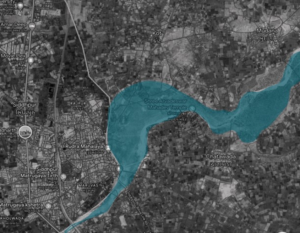
River and the Town(Source: Author)
Reading the river from its Riverbed
Aside from historical references to the river and its glory, it is critical to comprehend the river’s physical origins and characteristics. The geography and history of the Indian subcontinent indicate the existence of four different Saraswati rivers, each with its own form and characteristics. The Saraswati in Gujarat has an entire course of barely 200 kilometres, with its source at the Southwestern tips of the Aravalli hills. It originates near Ambaji in Koteshwar, and used to merge into the vast Kutch desert. Since it does not ‘wed’ the ocean, the river is popularly known as the ‘kumari‘ or Virgin River. Even though the watercourse is barely impressive, the river banks some renowned historical towns such as Siddhpur and Patan (important pilgrimage centres in Gujarat), which preserve the river’s memory.
The narrow river basin, as well as the architecture and infrastructure of the town built on the river’s banks, suggest that the river’s flow is irregular and low, classifying it as non-perennial. There are numerous baolis (step-wells), water reservoirs, tanks, and kunds, indicating that water was scarce in these towns during certain months of the year. The river, which is now dry, was once part of a well-functioning man-made water ecosystem for these towns.
The Saraswati Riverbed is quite visible in some areas, the most well-known being Siddhpur. In the past, the river appeared to continue until it reached the Rann of Kutch, but it is now barely visible beyond Patan. The river is said to have received water until 1975 before the Mukteshwar dam was built. Since then, the river has relied solely on rainfall, which does not help because most rainwater seeps underground.
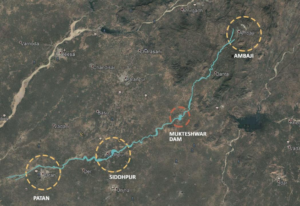
Origins and course of the river in the present day(Source: Sanika Divekar)
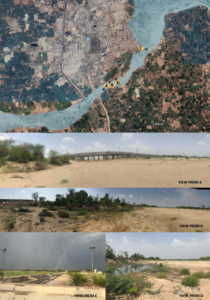
Current riverbed(Source: Sanika Divekar)
Remnants of the lost river
Tangible heritage: What Remained in the Physical form
The town has numerous historic temples, kunds, ghats, and monuments. The city was at its peak of fame and magnificence around the 10th century under the Solanki rulers. Siddhpur was built as the capital of the ruler Siddhraj Jaisingh, hence the name Siddhpur, literally meaning the town of Siddhraj. Rudra Mahalaya, a Shiva temple, was built by him. Rudra Mahalaya was a magnificent Shiva Temple with a three-story shikhara, 1600 pillars, 12 entrance doors, a central mandapa, and porches on the east, north, and south, and a sanctum in the west. There were 11 Rudra shrines around the temple. The eastern gate was adorned with intricately carved Toran, and a flight of steps led to the Saraswati River. Now, however, the famous Rudra Mahalya is in shambles.
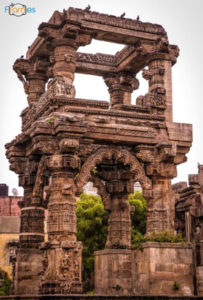
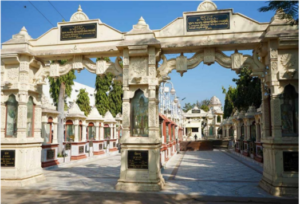
Numerous other temples exist in the area, including the Bhramandeshwar temple, the Siddheshwar Mahadev temple, the Ardeshwar temple, and the Vateswar and Valkeshwar temples. The Bindu Sarovar is a sacred tank where mathrushradd rituals are performed, and the temple attracts thousands of visitors annually. Saraswati Muktidham is a riverside cremation ground where people come to perform sacred funerary rites. It was named Gandharv Samshan (amongst the top four in India).
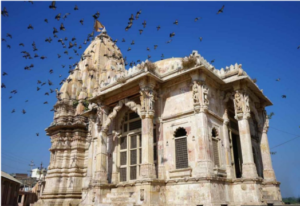
The numerous temples, ghats, and sacred structures dotting the town are the tangible legacy left behind by the Saraswati River.
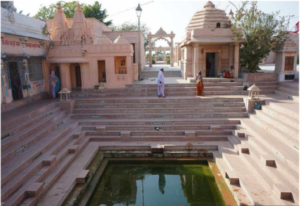
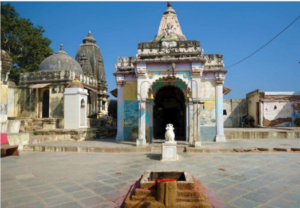
Intangible Heritage: ‘Concept of The Imaginary River’
Traditional water bodies have provided people with a wide range of intangible benefits, including cultural heritage, social connections, artistic inspiration, and various functions related to religion, spirituality, aesthetics, recreation, and environmental concerns. These intangible assets, which have influenced societal ideas and behaviours, are linked to the cultural heritage of the Saraswati River in Siddhpur. The cultural practices, festivals, celebrations, food, culture, oral histories, and so on have remained. It acts as a bridge for the people to sing about the river’s glory in real and legendary forms. Currently, the riverbank is used for community festivals, and locals and riverside temples hold various events throughout the year. During rituals and celebrations, the river’s ghats serve as a conduit for the people to connect with the river. The riverbed is where festivals, like Kartik, and large congregations such as melas take place, uniquely connecting people to the river.
Several rituals that require the presence of river water, such as burying ashes or performing havans, are still carried out on the dry river bed. The mythical importance of the river and the personification of the river as a goddess has led to the concept of the imaginary river, in which the riverbed is given significance and rituals are performed, even though the river no longer exists in its physical form, and there is no flowing water naturally. This strong cultural memory is what keeps the river alive for generations to come.
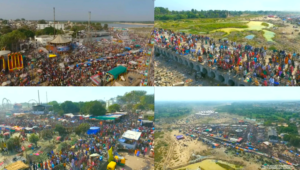
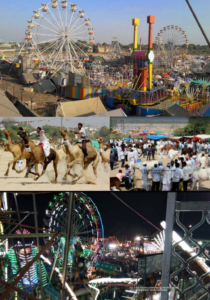
Identifying Gaps
Measuring the loss
As the Saraswati began to dry up, the town’s cultural lustre faded, harming the entire tourism industry. The once-active riverfront is now abandoned and artificially flooded yearly for ritualistic purposes and to replenish the town’s groundwater supply. The riverfront is used for neighbourhood festivals and various events throughout the year by the people and the riverside temples. With the river drying up, all of the majesty and splendour of the Vedic era has faded. The town of Siddhpur, which was at its peak glory and was almost worthy of being called Gujarat’s capital city, is now a small industrial town unknown to the general public. Even though it has the potential to become a major pilgrimage and tourist destination, Siddhpur’s growth has stalled.
The cultural heritage and monuments around town are undervalued and in poor condition due to a lack of awareness and knowledge of their significance. Aside from the cultural losses, the town’s ecology suffers as well. Wells and borewells are frequently overused due to a lack of water, resulting in a lack of natural drinking water and supply dependency. The lack of groundwater recharge also impacts the local flora and fauna.
Painting the Current Picture
Present conditions of the Riverbed: Problems and major challenges
The river bed of Siddhpur is currently its most important asset and most neglected and ill-maintained location. The ghats retain the riverbed’s religious significance, while the rest face industrial pollution and illegal dumping issues. Because of this, the lush terrain below and the river’s sacred status are now jeopardised. Bore wells nearby have also been impacted and cannot be used for irrigation or drinking. This is harmful to public health and causes significant environmental damage. The Gujarat High Court recently ordered the Sidhpur municipality to stop dumping trash into the Saraswati River in response to a petition. It threatened to take over the municipal body if the practice continued. This action was taken to keep the river from becoming a landfill. Celebrations such as the Kartik Mela festival, which takes place on the riverbed, frequently leave it clogged with waste disposal and pollution, with no action taken by municipal authorities. Another issue at hand is urban encroachment. Pilgrimages contribute trash to the river to some extent.
There is a severe lack of awareness among higher authorities about the issues at hand and the gravity of the problems. Due to the negligence and lack of initiative of local governing bodies and municipalities, the town’s people continue to make little to no effort to preserve the riverbed.
River neglect can be one of the most important causes of city death, whereas river revival has become a must for cities aiming for re-living and development.
Proposals and their Analyses
The most pressing issue, which has received the most attention, has been water restoration to the river. The dam at Mukteshwar is primarily responsible for the river’s near-zero flow compared to the seasonal flow it used to have. But, even if the dam were removed, would the river continue to flow or be perennial? In the current scenario, the chances appear to be slim.
The current practice of diverting water from the Narmada for ritualistic and groundwater recharge purposes appears to address the problem only superficially. It does not provide any viable long-term solutions to the river’s problems.
In 2005, then-chief minister Narendra Modi held a puja in Siddhpur and ordered the diversion of Narmada water into the legendary Saraswati River to revitalise it and develop a riverfront across it. Still, nothing came of it because the state backed down and declared the body non-perennial. Questions about the project’s intention and justification arose as well. The proposal was also questioned regarding feasibility and whether it was essential.
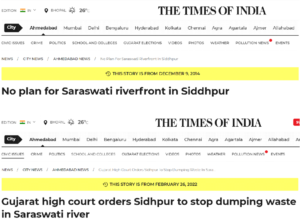
The Way Forward?
Is it necessary to resurrect a dead river for religious reasons at great expense in terms of infrastructure? Can a river be kept alive in its imagined form indefinitely? Is there any natural way to restore the river?
Although the importance of permanent watercourses is frequently recognised, the prevalence, value, and fate of non-perennial and lost rivers and streams that cease to flow regularly are frequently overlooked. Only by determining their cultural and ecological importance can we determine whether the river and its ecosystem are worth restoring.
The Saraswati in Siddhpur is more than just a town’s past glory and story; it also holds great future potential and opportunities for the town. The cultural heritage of Siddhpur should not be preserved solely to keep it alive and preserve history; instead, it should be held as an asset for the town’s growth, which adds further value and reasoning for its preservation. The ecological conservation of the river is an urgent need that can serve as a barrier to future developments, exploiting the river as a source of tourism and pilgrim abuse.
Although the correct approach for revitalising the riverbed is debatable and would necessitate extensive research and studies to establish a concrete solution, the need for revitalisation may be justified.
References
Anonymous. (2014). No plan for Saraswati riverfront in Siddhpur. Times of India. https://timesofindia.indiatimes.com/city/ahmedabad/no-plan-for-saraswati-riverfront-in-siddhpur/articleshow/45421351.cms
Anonymous. (2022). Gujarat high court orders Sidhpur to stop dumping waste in Saraswati River. Times of India. https://timesofindia.indiatimes.com/city/ahmedabad/gujarat-high-court-orders-sidhpur-to-stop-dumping-waste-in-saraswati-river/articleshow/89839322.cms
Danino, M. (2010). The Lost River: On The Trail of the Sarasvati. Penguin India.
Divekar, S. (2019). Reminiscence of the lost river: revitalisation of the riverfront of Siddhpur.
Hattangadi, V. (2007). River Saraswati and Gujarat. Blogspot. http://riversaraswati.blogspot.com/
Rajendran, A. (2016). Siddhpur – History – Association With Saraswati River. Hindu Blog. https://www.hindu-blog.com/2022/08/siddhpur-history-association-with.html
Sanyal, S. (2013). Land of the Seven Rivers: A Brief History of India’s Geography. Penguin India.
